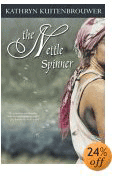The Nettle Spinner

by Kathryn Kuitenbrouwer
326 pages,
ISBN: 0864924224
Post Your Opinion | | Northern Ontario Woods Transformed
by Theresa Kishkan
As a girl, my favourite fairy tale was "The Wild Swans". In Hans Christian Andersen's
story of loyalty and resourcefulness, a beautiful maiden, Elise, weaves shirts of stinging
nettles for her brothers, changed to swans by a wicked stepmother. When the shirts are
pulled over the swans' heads, the birds become young men again. This collision of the
ordinary¨a plant which grew in vacant lots and along roadsides¨with the
extraordinary¨shirts which could reverse a powerful spell¨appealed to my imagination
and served as an early template for good storytelling. The tale contained compelling
elements: a stepmother, a dark churchyard, an ardent prince, goodness and faith. I loved
that Elise saves her brothers after a long and thorough immersion in the wild landscape.
She bathes with toads, she is anointed with walnut juice, and sheltered among the heavy
boughs of crab-apple trees. Ultimately, she is brought back from near-death by funeral
sticks miraculously changed to roses.
The Nettle Spinner, by Kathryn Kuitenbrouwer, is a marvellous novel with something of
the magic of the best fairy tales in its structure, its timing, and in its richly textured
narrative terrain. At the heart of the novel is Alma, a tree-planter. She is working with a
team replanting a northern Ontario forest. In her dome tent she is also experimenting with
the process of turning nettles to durable fibre¨retting, scutching, carding and spinning.
Her story follows a trajectory which echoes and resonates with the tale of Renelde, the
protagonist of Andrew Lang's retelling of a Flemish fairy tale, "The Nettle Spinner".
Each young woman is the object of wanted and unwanted attention; for each the act of
preparing yarn from stinging nettles and then weaving with it is a way of endowing their
stories with a visual dimension, as well as creating something emblematic.
Would Renelde exist without Alma's fascination with her? And would Alma exist, with
her yarns and story cloth, her admirers and her strange Rumpelstiltskin protector, without
Renelde? The Nettle Spinner's prologue prepares the reader for the twinned narratives
and the way they comment on, penetrate and mirror one another, and finally go their
separate ways. The novel wanders through the bleak woods of Ontario and Flanders,
between the past and the present. We follow Alma as she anticipates the birth of a child,
not entirely wanted, and negotiates the winter in an abandoned mining camp. In a series
of dramatic flashbacks, we learn of her love affair with a woodcutter and a series of
encounters with predators, human and ursine. We follow the courtship of Renelde by
Guilbert, also a woodcutter, and by Burchard the Wolf, a wealthy Count. Both landscapes
are evoked with exquisite detail, from the plants to the insects, the weathers that influence
the characters, and the human passions that play out against the backdrop of wilderness.
These are not enchanted forests, exactly; there are no rose bowers or talking birds. These
woods are redolent of bear scat, carpeted with thorny brambles, and the air is thick with
noxious insects ("Willem bent over and pulled his pant leg up over his boot, then pulled
his boot off. There were scores of suckling blackflies there, and little runnels of blood
oozing down . . . "). There is a lot of sex and the language of the novel is suitably earthy
and pungent: "I take his index finger and I draw a line over my breast and down into the
double-u of my sex. His hand, I turn it around and use it to hold myself. I am just
becoming thoroughly wet, the wet is surging through my body . . . " In the tree planters'
camp, people pair up¨". . . slim-pickin's treeplanting camp world, where musical tent
was one of the favourite pastimes . . . "¨or take pleasure on their own, constantly
aroused by the intense physicality of plunging small trees into wedges in the earth: "the
hidden joy in every stimulation." On every level Kuitenbrouwer meets the challenges
presented by the use of intertextual presentation. Seldom have I read a novel so cleverly
interwoven, where one story is resident within the other, and where the physical world so
devoutly echoes the emotional topography.
The Nettle Spinner pays homage to a long tradition of story-telling and confidently aligns
itself with the literature we might call mythic in structure and theme¨I am thinking here
of Murray Bail's Eucalyptus, for example, or Barbara Lambert's The Allegra Series, or
Elizabeth Hay's A Student of Weather¨and it does so with wit and originality. The ethos
of this novel is both recognizable and larger than life, anchored by work and drudgery
(the back-breaking world of treeplanting camps and mining settlements; homely huts
with little light in the midst of nowhere), then reaching for the larger patterns of heroic
quest, loss of self, rebirth, and the transformative power of art. The characters, scarred
and pocked from the hazards of life, plunge into a bottomless pool to emerge clean and
new. Alma and Renelde, both survivors of a violent act, engage in the hard task of
weaving their own stories from a coarse and caustic fibre. Straw to gold, a silver spoon
polished to a high gleam, wolves making a fierce music at the door¨Kathryn
Kuitenbrouwer has done a wonderful job of taking the reader on a journey both wondrous
and terrible. I look forward to whatever this gifted writer might do next.
|